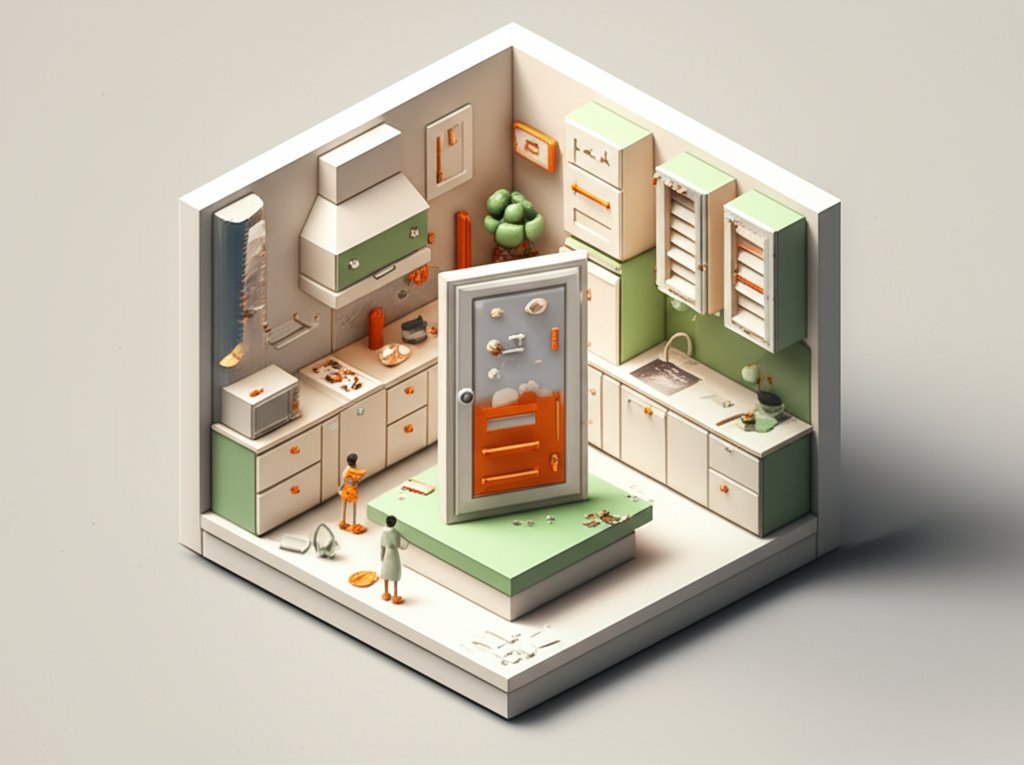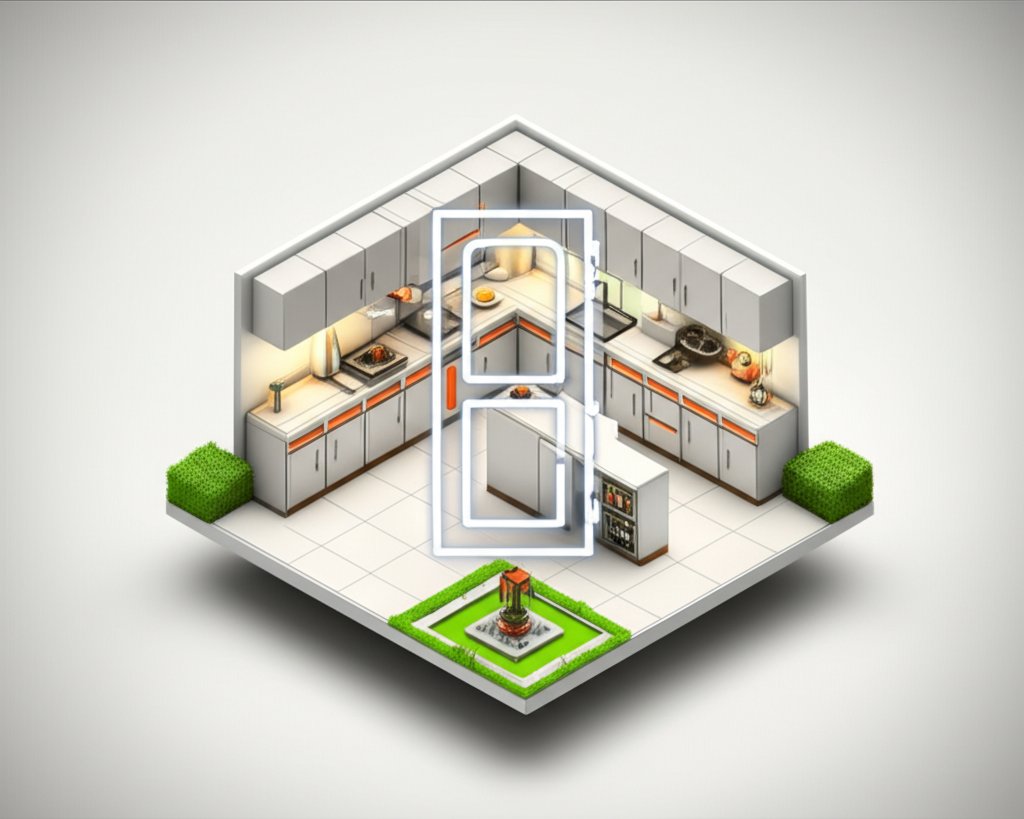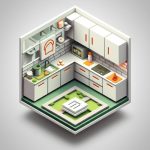The right kitchen door isn’t just a barrier; it’s a statement. It can dramatically impact the flow, feel, and functionality of your kitchen, seamlessly connecting it to the rest of your home while reflecting your personal style. Thinking about upgrading? Let’s explore some exciting ideas for kitchen doors that will inspire your next renovation.
At a glance:
- Space-Saving Solutions: Pocket and folding doors maximize space in smaller kitchens.
- Style Statements: French, louvered, and chalkboard doors add unique character.
- Material Variety: Choose from wood, glass, metal, and more to match your décor.
- Functionality Matters: Consider ventilation, privacy, and ease of use when selecting your door.
Why the Right Kitchen Door Matters
A kitchen door plays a crucial role. It controls noise and odors, provides a visual separation, and contributes significantly to the overall aesthetic. A poorly chosen door can hinder workflow and make the space feel cramped. Conversely, a well-selected door can enhance the kitchen’s functionality and visual appeal, making it a more enjoyable place to be.
Key Considerations Before You Choose
Before diving into specific styles, it’s essential to consider these factors:
- Available Space: Do you have room for a swinging door, or is a space-saving option like a pocket door more suitable?
- Kitchen Layout: How does the kitchen connect to other rooms? The flow between spaces will influence your door choice.
- Desired Style: Do you prefer a modern, rustic, traditional, or eclectic look? Your door should complement the existing décor.
- Budget: Door prices vary widely depending on the material, style, and complexity of installation.
- Functionality: Do you need the door for privacy, soundproofing, or simply to delineate the space?
Explore Different Kitchen Door Style Ideas
Let’s dive into some popular and innovative kitchen door styles to spark your creativity.
1. Classic French Doors
French doors bring an elegant touch and an abundance of natural light into your kitchen. Characterized by glass panes that extend across most of the door’s surface, these doors create a visually open and airy feel.
- Pros: Enhanced natural light, elegant aesthetic, creates a sense of spaciousness.
- Cons: Requires significant swing space, limited privacy unless using frosted glass.
- Best For: Kitchens connected to dining rooms, patios, or gardens. Ideal for those who appreciate natural light and a classic design.
2. Space-Saving Pocket Doors
Pocket doors slide horizontally into the wall cavity, effectively disappearing when open. This design is a game-changer for small kitchens or in open-concept layouts where a swinging door would obstruct traffic flow.
- Pros: Maximizes space, sleek and modern look, provides a clear opening between rooms.
- Cons: Requires specific wall construction, can be more complex to install, potential maintenance issues with the track mechanism.
- Best For: Small kitchens, open-concept homes, areas where space is a premium.
3. Versatile Folding Accordion Doors
Folding or accordion doors offer another space-saving solution, especially useful for large openings or creating flexible room divisions. These doors fold back into compact panels, minimizing the footprint and maximizing usable space.
- Pros: Space-saving, versatile, allows for wide openings, can be customized with different materials.
- Cons: Can feel less substantial than traditional doors, may not provide as much sound insulation.
- Best For: Creating flexible spaces, connecting kitchens to outdoor areas, dividing large rooms.
4. Charming Louvered Doors
Louvered doors feature horizontal slats that allow for airflow and ventilation, making them a great choice for pantries or kitchens where airflow is desired. They add casual, breezy aesthetic.
- Pros: Excellent ventilation, adds a unique design element, can provide partial privacy.
- Cons: Limited privacy, can be difficult to clean, may not suit all kitchen styles.
- Best For: Pantries, kitchens that need extra ventilation, creating a relaxed and informal atmosphere.
5. Functional Chalkboard Doors
Turn your kitchen door into a dynamic message board with a chalkboard finish. This is a fun and practical option for families, allowing you to jot down grocery lists, recipes, or daily reminders.
- Pros: Functional and fun, provides a writable surface, adds a unique design element.
- Cons: Requires regular cleaning, may not suit all kitchen styles, chalkboard paint can be prone to scratching.
- Best For: Family kitchens, creative spaces, adding a personal touch.
6. Rustic Barn Doors
Barn doors, with their sliding mechanism and rustic charm, have become increasingly popular in recent years. They add a touch of farmhouse or industrial style to any kitchen.
- Pros: Unique and stylish, saves space compared to swinging doors, can be made from reclaimed materials.
- Cons: Does not provide a tight seal, can be noisy to operate, requires sufficient wall space for sliding.
- Best For: Farmhouse-style kitchens, adding a rustic touch, creating a focal point.
7. Sleek Glass Panel Doors
Using glass panels, whether clear, frosted, or textured, can add a modern touch to your kitchen door. This allows natural light to permeate while maintaining some level of privacy, depending on the glass type.
- Pros: Modern aesthetic, allows natural light, available in various glass textures and finishes.
- Cons: Can show dirt and smudges, may require regular cleaning, less privacy with clear glass.
- Best For: Contemporary kitchens, maximizing natural light, creating a bright and airy space.
8. Custom-Designed Doors
Don’t limit yourself to standard options. Work with a designer or craftsman to create a custom kitchen door that perfectly matches your vision and needs. Charming Kitchen Cabinet Door Ideas can also translate to full-scale door design, inspiring truly unique statements.
- Pros: Unique and personalized, tailored to your specific needs, allows for complete design control.
- Cons: Can be more expensive, requires more time and effort, may require specialized installation.
- Best For: Homeowners with specific design preferences, those seeking a one-of-a-kind look, unique architectural situations.
Material Matters: Choosing the Right Materials
Once you’ve selected a door style, consider the materials. Here are some popular options:
- Wood: A classic and versatile choice, wood doors can be painted, stained, or left natural to match any décor.
- Glass: Glass doors offer a modern and airy feel, allowing natural light to flow through.
- Metal: Metal doors provide a durable and industrial look, often used in contemporary kitchens.
- Fiberglass: A durable and low-maintenance option, fiberglass doors are resistant to moisture and warping.
- Composite: These doors combine various materials for enhanced durability and energy efficiency.
Smart Additions: Hardware and Finishes
The hardware and finish are the finishing touches that can elevate your kitchen door.
- Handles and Knobs: Choose hardware that complements the door style and overall kitchen design.
- Hinges: Select durable hinges that can withstand frequent use.
- Finishes: Consider the durability and maintenance requirements of different finishes, such as paint, stain, or varnish.
Installation Tips and Considerations
Proper installation is crucial for the longevity and functionality of your kitchen door.
- DIY vs. Professional Installation: Assess your skills and experience to determine whether you can install the door yourself or if you need to hire a professional.
- Framing: Ensure the door frame is square and plumb for proper door alignment.
- Hardware Installation: Follow the manufacturer’s instructions carefully when installing hardware.
- Sealing: Seal the door properly to prevent drafts and moisture damage.
Addressing Common Questions
Let’s tackle some frequently asked questions about kitchen doors.
Q: How do I choose the right size for my kitchen door?
A: Measure the width and height of the door opening accurately. Standard door sizes are typically 30, 32, or 36 inches wide and 80 inches tall. However, custom sizes may be necessary for older homes or unique architectural designs.
Q: What is the best material for a kitchen door that will be exposed to moisture?
A: Fiberglass or composite doors are excellent choices for kitchens as they are resistant to moisture, warping, and rot. Wood doors can also be used, but they require proper sealing and maintenance to prevent damage.
Q: How can I soundproof my kitchen door?
A: Use a solid-core door made of wood or composite materials for better sound insulation. Add weather stripping around the door frame to create a tight seal and prevent sound from escaping.
Q: Are there any energy-efficient kitchen door options?
A: Yes, look for doors with energy-efficient features such as insulated cores, low-E glass, and tight-fitting seals. These features can help reduce energy consumption and lower utility bills.
Expert Insights on Future Trends
According to a recent article in Kitchen & Bath Design News, expect to see a rise in smart doors with integrated technology, such as automated opening and closing, security features, and voice control. Sustainable and eco-friendly materials will also become increasingly popular, with homeowners opting for reclaimed wood, bamboo, and recycled materials.
Take Action: Finding the Perfect Kitchen Door for Your Home
Choosing the right kitchen door is an investment in your home’s comfort, functionality, and style. Take the time to explore your options, consider your needs, and select a door that you’ll love for years to come.
When exploring different kitchen cabinet door ideas, remember that the principles of color, texture, and overall flow also apply to choosing a kitchen door.
- Assess Your Space: Accurately measure your door opening and consider any spatial limitations. This will help you narrow down the suitable door styles.
- Define Your Style: Determine the overall style of your kitchen and choose a door that complements it. Consider the colors, materials, and architectural details.
- Explore Your Options: Visit local home improvement stores, browse online catalogs, and consult with designers to gather inspiration and ideas.
- Consult Professionals: Don’t hesitate to seek advice from experienced contractors or designers. They can provide valuable insights and help you avoid potential pitfalls.
- Prioritize Quality: Invest in a high-quality door that is durable, functional, and aesthetically pleasing.
- Plan Installation: Whether you opt for DIY or professional installation, plan the process carefully to ensure a smooth and successful outcome.

- Glass On Tile: A Stylish Kitchen Backsplash Option - December 1, 2025
- Glass Tiles for Kitchen: Style and Durability Tips - November 30, 2025
- Decorative Wall Tiles for Kitchen: Stylish Design Ideas - November 29, 2025










